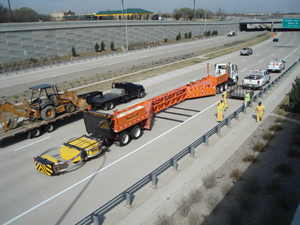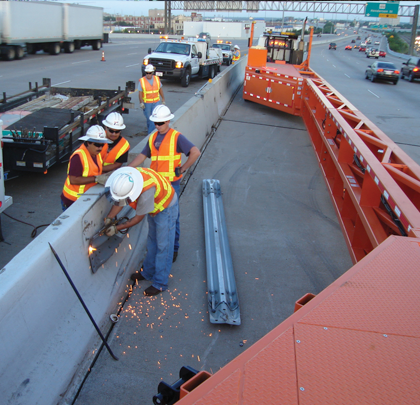Keeping workers safe and traffic moving in the Lone Star State
It’s been an extraordinary spring for Mobile Barriers with orders for 10 new barriers and increasing international uptake. The company is expanding through the U.S. and Canada, and by year-end hopes to open markets in Australia, the Mid-East, and Europe.
So what state in the U.S. is leading the way in the use and purchase of mobile barriers? The answer is Texas, with an expected 11 mobile barriers by late summer 2014.
The North Texas Tollway Authority (NTTA) acquired one of the first MBT-1 (Mobile Barrier Trailer) and now has three barriers operating on its roadways (two under direct ownership and a third under an asset management contract) with plans to add another under a similar contract this summer for a total of four barriers. NTTA uses the barriers heavily, and last fall was specially recognized for their advances in safety by ARTBA.
NTTA RECEIVED SAFETY AWARD
The NTTA Maintenance Department received the 2013 Roadway Work Zone Safety Awareness award in the local/municipal training category from the American Road and Transportation Builders Association (ARTBA). The annual awards program recognizes specific programs, education campaigns, or innovations in technology that demonstrate excellence in promoting safety in roadway construction zones.
NTTA was the first entity in Texas to use mobile barriers to protect drivers and work crews during short-term roadside maintenance projects where use of a semi-permanent concrete barrier was not feasible.
After NTTA bought its first mobile barrier in 2009, maintenance staff quickly experienced its ease of use and protection from traffic. NTTA purchased a second barrier in 2010, and both barriers are used daily, more than earning a return on the investment for each barrier.
EASE OF USE
The barriers are driven to the worksite set up, reducing the amount of time workers are in the lane, and thus the amount of time traffic is impeded. The barrier consists of a smooth steel wall with an impact cushion on the end facing oncoming traffic. It can be configured from 42 feet to more than 100 feet for a left or right side of road placement. Federally required crash tests showed that the barrier can effectively redirect and absorb the impact of a 2.5–ton vehicle (such as a passenger vehicle or a pickup) going more than 60 miles per hour.
Traditional barrier methods for work zones are either ineffective against high-speed traffic or take significantly longer to deploy than the actual time needed to complete the short-term project. Having a quick and effective way to provide positive protection from oncoming traffic assures full compliance of safety procedures among ma intenance work crews.
intenance work crews.
TEXAS MAKING BARRIERS AVAILABLE
The Texas Department of Transportation (TxDOT) had experience working at times around the NTTA barriers and one Mobile Barriers lent them. Last fall, TxDOT acquired its first barrier. It was initially delivered to San Antonio, but soon traveled to various locations around the state. TxDOT recently placed an order for additional barriers, which will raise the number to 7 barriers in operation by late summer. TxDOT has noted it is considering leasing or purchasing as many as 20 more barriers, which they may allow contractors to use around the state. The later is not a new concept as it has been used with other equipment (including bridge equipment and interestingly even message boards when they were first introduced in some states). It would allow states to obtain the barriers on the most favorable terms, and enable all contractors to compete for applicable work and still use the barrier, which offers improvements in safety and efficiency for the work crews, and improved safety and traffic flows/mobility for the public.
TxDOT is really showing leadership, both in terms of its focus on its people and the traveling public, and in one of the best strategies for supporting its contractors as well.
WIN-WIN
Mobile Barriers MBT-1 has received multiple awards and growing accolades for improving safety, efficiency, and traffic flows in and around work zones. It drives set up to the worksite like a regular semi, and provides front, rear, and lateral protection otherwise impractical and time/cost prohibitive for short-term, intermittent, and continuous moving for day or night operations. In some cases, crews are doing in one night what otherwise took 3 to 5 days, with improved safety and traffic flows. For workers, it improves safety and efficiency. For the public, it improves safety and traffic flows for better mobility. For all, it’s a win.
■ ■ ■
[divider]
For More Information For more information about Mobile Barriers and its MBT-1, visit www.mobilebarriers.com.
Modern Contractor Solutions, JULY 2014
Did you enjoy this article?
Subscribe to the FREE Digital Edition of Modern Contractor Solutions Magazine!


